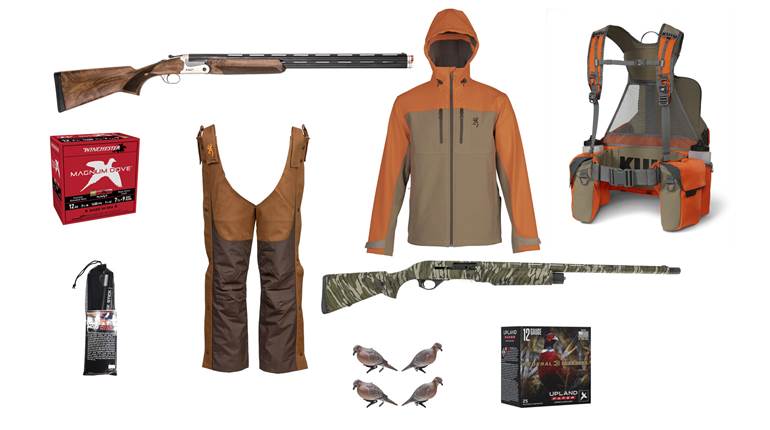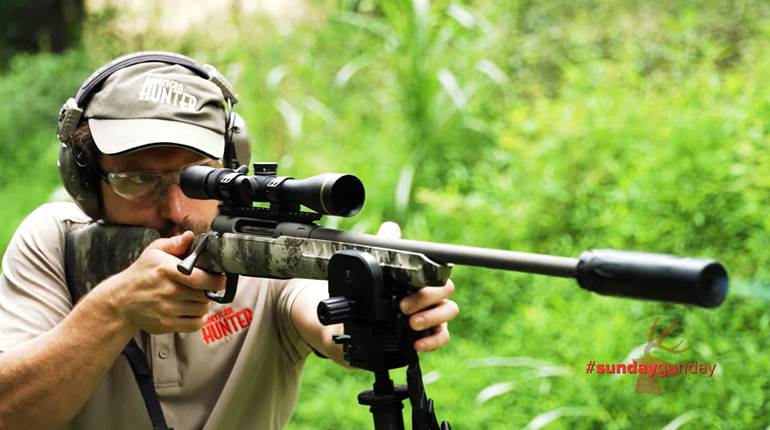
Since its introduction in 1985, the A-Bolt bolt-action rifle has remained a stalwart in the Browning lineup. Perhaps the most specialized model to appear in the period since is the 12-gauge A-Bolt Shotgun, which made its debut in 1995 and was removed from company literature a mere four years later. Built on the A-Bolt II action, the shotgun was offered with either a fully rifled barrel or a smoothbore threaded to accept Invector choke tubes. A 6" rifled choke tube accompanied the latter. In 2011, Browning reintroduced the A-Bolt Shotgun; all four variants-Hunter, Medallion, Stalker and Mossy Oak Break-Up Infinity-have fully rifled barrels. The Stalker is evaluated here.
Barrel movement, which is a by-product of most shotgun designs, is detrimental to accuracy, and is often remedied through pinning. No such problem exists with the A-Bolt Shotgun, as the barrel is threaded directly into the receiver. Secured in place between the barrel and receiver is the recoil lug. Further, rather than rely on a cantilever-style mount or drilled-and-tapped aluminum receiver, the latter being common to many newer shotguns, scope bases are anchored solidly to a steel receiver. Browning notes, however, that standard A-Bolt bases are incompatible; versions are readily available for the Stalker, though.
The steel receiver measures 1.385-inches wide, and from its front to the tang is 9.50 inches. The oversize ejection port is shaped to ensure reliable removal of the hulls, which are sent outward by the combination of a fixed projection and an ejector spring. On the left rear of the receiver is the oversize bolt stop/release. Affixed to the receiver’s round bottom is the fire-control housing, with the most noticeable feature being Browning’s gold-colored trigger shoe. Although the trigger can be adjusted from 3 pounds to 6 pounds, 8 ounces, the factory-set 3-pound, 4.5-ounce pull-with no discernible creep or overtravel-was deemed ideal by the evaluators, and no doubt contributed to the gun’s respectable accuracy. The tang-mounted safety has two positions-safe and fire-and the bolt cannot be operated with the safety engaged.
The Shotgun Stalker’s bolt is unique in that there is a polymer sleeve atop the steel core that increases the diameter to equal that of the head. Besides saving weight, the polymer’s lubricity facilitates unrestricted cycling even without lubrication; however, should the action get inundated with water, care should be taken to ensure that the metal beneath the sleeve does not rust. On the bolt’s head is a single spring-tensioned extractor on the right lug, and the other two lugs have spring-powered projections that aid in securing the shell in place. The three-lug design also results in a 60-degree bolt lift. Beneath the bolt shroud is a cocking indicator.
To slow heating and increase rigidity, the blued, 22-inch barrel, which measures 1.225 inches in diameter at the recoil lug and tapers to 0.975 inches at the muzzle, is 0.125-inches thick. The rifling, which is applied in a 1:28-inch rate of twist, is protected by a recessed muzzle crown. Topping the barrel are steel sights; the rear has a U-notch and is windage- and elevation-adjustable, while the TRUGLO/Marble’s front has a red fiber-optic pipe in a windage-adjustable base dovetailed into place on a separate base that is secured to the barrel by screws.
To increase its resistance to inclement conditions, the composite stock has Dura-Touch, a coating that expels water, perspiration and similar liquids while enhancing grip. Further increasing purchase are panels of checkering in the wrist and fore-end areas. Interestingly, at the front of the receiver, in the recoil lug area, the stock is glass-bedded to prevent movement of the barreled action and ensure consistency. The stock has dual sling swivel studs and a rubber ventilated recoil pad, though the latter’s hardness does little to mitigate recoil.
Lastly, the Shotgun Stalker’s two-piece bottom metal is, indeed, metal. Depressing the magazine-release button on the front of the trigger guard allows the drop-out floorplate to swing downward, exposing the magazine. Once opened, the steel, two-round-capacity magazine can be removed from the floorplate for easy unloading.
Following the American Rifleman protocol of firing five consecutive, five-shot groups at 100 yards with three loads-in this case two 12-gauge 2¾ inch and one 3 inch-we anticipated that the Shotgun Stalker, topped with a Nikon 2-7X 32 mm Prostaff Shotgun Slug scope, would perform well. It did not disappoint. At times, a 3-inch chambered slug gun, such as the Stalker, performs less impressively with 2¾-inch loads than with 3 inches because of the extra freebore; however, the test gun performed similarly with the 3 inch and one of the 2¾-inch loads. That being said, Federal’s 3-inch 300-gr. Trophy Copper, which averaged 2.80 inches for 25 shots, edged out Remington’s 385-grain AccuTip, which averaged 2.94 inches. During the chronographing phase of testing it was recognized that the loss of velocity from published factory data due to the A-Bolt’s short 22-inch barrel was between 175 f.p.s. to 225 f.p.s., which is fairly substantial.
During testing there were no malfunctions, and feeding was exceptionally smooth. We also appreciated the fact that the magazine could be readily inserted and removed upon entering the field or heading out without having to cycle all rounds through. In the hands, the Shotgun Stalker feels like a well-crafted dangerous game rifle.
For the hunter who hunts routinely, if not exclusively, in slug-only areas, or where protection is needed from large bruins and slugs are preferred, it would pay dividends to make a one-time commitment to assure optimum performance in the field. For the money, the A-Bolt Shotgun Stalker is hard to beat. We’re glad to see Browning bring it back.
Browning A-Bolt Shotgun Stalker
Manufacturer: Miroku, Kochi, Japan
Importer: Browning (Dept. AR), One Browning Place, Morgan, UT 84050; (801) 876-2711
Caliber: 12-ga. 3" (2¾" compatible)
Action Type: bolt-action, repeating shotgun
Barrel: 22" steel, heavy contour
Rifling: eight-groove, 1:28" RH twist
Magazine: drop-out floorplate with detachable two-round-capacity magazine
Sights: windage- and elevation-adjustable rear, windage-adjustable Marble’s fiber-optic front; receiver drilled and tapped for scope bases
Trigger: single-stage; adjustable; 3-lb., 4.5-oz. pull
Stock: synthetic with Dura-Touch coating; length of pull, 13 5⁄8"; drop at comb, 2"; drop at heel, 2 1⁄8"
Overall Length: 4 3¾"
Weight: 7 lbs., 6 ozs.
Accessories: owner’s manual
Suggested Retail Price: $1,150





































